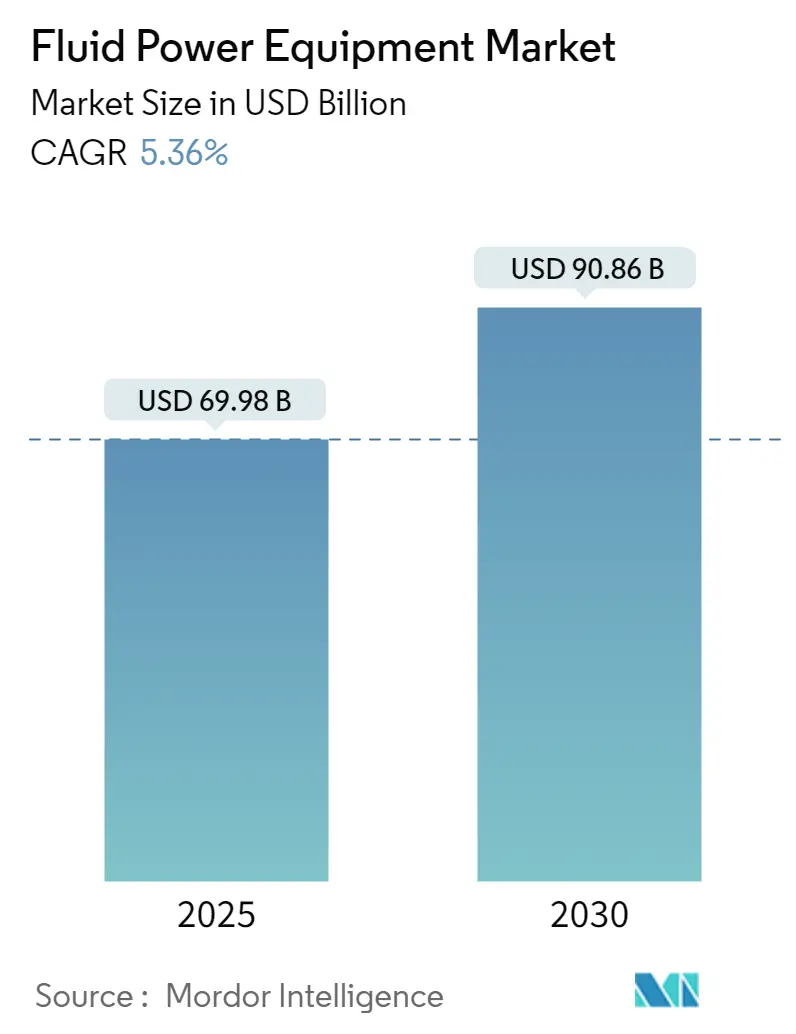
| Study Period | 2019 - 2030 |
| Market Size (2025) | USD 69.98 Billion |
| Market Size (2030) | USD 90.86 Billion |
| CAGR (2025 - 2030) | 5.36 % |
| Fastest Growing Market | North America |
| Largest Market | Asia-Pacific |
| Market Concentration | Medium |
Major Players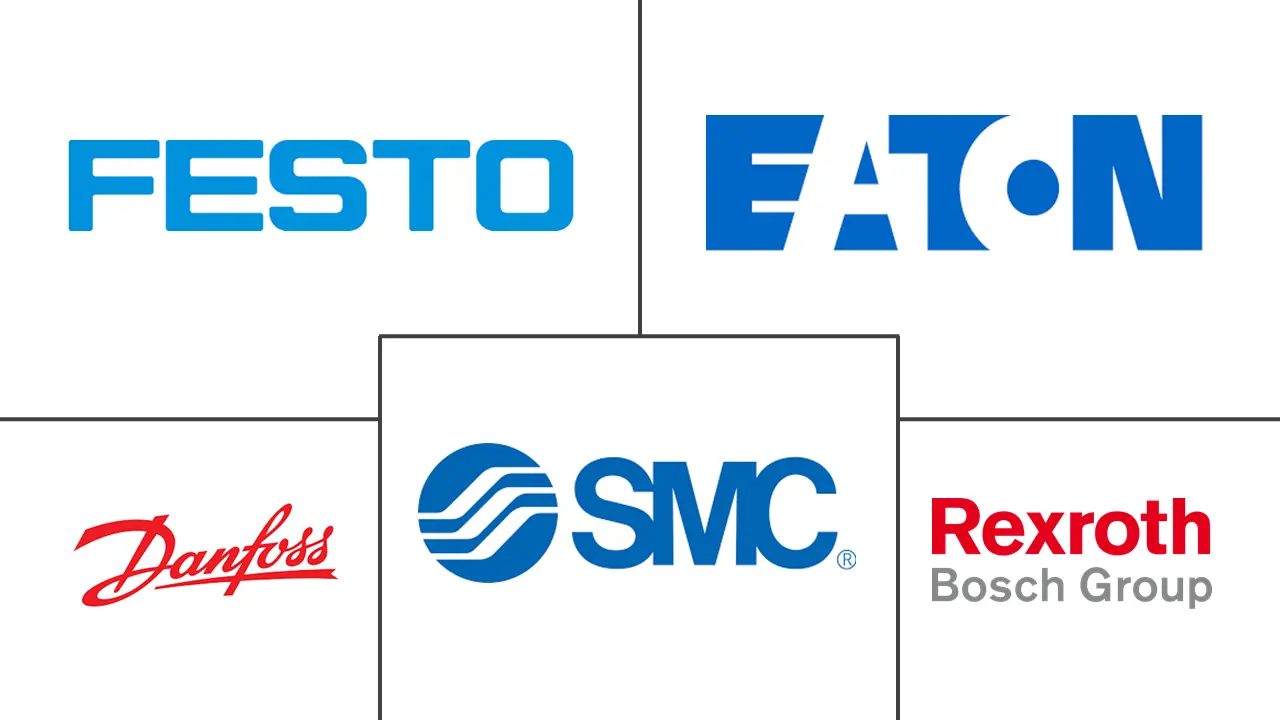
*Disclaimer: Major Players sorted in no particular order |
Fluid Power Equipment Market Analysis
The Fluid Power Equipment Market size is estimated at USD 69.98 billion in 2025, and is expected to reach USD 90.86 billion by 2030, at a CAGR of 5.36% during the forecast period (2025-2030).
The fluid power equipment industry is experiencing a significant transformation driven by the widespread adoption of Industry 4.0 and automation technologies. The automotive sector leads this transformation with a 36% Industry 4.0 adoption rate, followed by the computer electronics and metals/mining industries at 29% each, highlighting the increasing integration of smart technologies across manufacturing sectors. This technological evolution has prompted manufacturers to focus on creating synergy between hydraulic products and electrical systems, leading to innovations in liquid power transmission, mobile diagnostic tools, and electrohydraulic control systems. The industry's shift towards intelligent environments has resulted in the development of simplified hose selection processes and advanced thermoplastic components, enabling more efficient and precise operations.
The market is witnessing a notable trend towards predictive maintenance and equipment optimization strategies. Companies within the fluid power industry are increasingly emphasizing regular maintenance protocols to minimize repair costs and reduce operational downtime, with maintenance activities ranging from quick equipment checks to comprehensive system overhauls. This focus on maintenance optimization has led to the development of innovative solutions, as exemplified by REHOBOT Hydraulics' launch of the PME70-2500MRV/VR70 electric-powered hydraulic pump in April 2023, featuring a low-maintenance induction motor designed for diverse industrial applications. The integration of smart monitoring systems has enabled real-time equipment health tracking, allowing operators to schedule maintenance activities proactively.
The manufacturing sector's evolution has become a crucial driver for fluid power equipment adoption, particularly in developed economies. In the United States, manufacturing accounts for 10.9% of total employment, with fluid power systems being integral to various manufacturing processes. The industry is experiencing a significant push towards reduced fluid volumes relative to pump flow rates, resulting in smaller and lighter equipment designs. This optimization trend has led to improved efficiency in mobile hydraulic equipment, with reduced cooling time requirements and better air management systems.
The construction industry's technological advancement has created new opportunities for fluid power equipment applications. The sector has witnessed substantial growth in the implementation of automated systems and smart technologies, particularly in heavy machinery and material handling equipment. The integration of advanced hydraulic systems with electronic controls has enabled more precise operations and improved safety features. This evolution is particularly evident in the development of electrohydraulic systems that offer enhanced control capabilities and operational efficiency, supporting the industry's move towards more sophisticated and automated construction processes.
Fluid Power Equipment Market Trends
Increasing Demand for Material Handling Equipment
The growing sophistication of material handling operations across industries has created substantial demand for fluid power equipment. Material handling equipment ensures high efficiency and productivity by speeding up the movement of equipment while simultaneously reducing labor costs by eliminating the requirement of manual labor. The equipment also plays a crucial role in the construction of storage facilities and optimization of warehouse operations. The proliferation of stock-keeping units (SKUs) in the e-commerce market has resulted in significant growth in the number of distribution centers utilizing material handling equipment globally, driving the demand for both hydraulic and pneumatic systems.
The integration of advanced hydraulic and pneumatic systems in material handling equipment has revolutionized the efficiency of operations across various industries. For instance, hydraulic systems are extensively used in forklifts, where depending on the number of lift stages for the mast, there could be one, two, or three lift cylinders employing counterbalance valves. These systems are particularly valuable in heavy forklifts where enormous gravitational potential energy is involved in boom operations. Similarly, pneumatic conveying systems have gained prominence in industries requiring the transfer of materials like powders, tablets, grains, and empty capsules, offering advantages such as dust-free atmosphere maintenance and minimal cleaning requirements.
Rising Construction Activity Across Geographies
The construction industry's robust growth has emerged as a significant driver for the fluid power equipment market, with increasing demand for hydraulic and pneumatic systems in construction machinery and equipment. The extensive use of hydraulic systems in construction equipment such as excavators, steamrollers, backhoe loaders, concrete machines, and drilling rigs has created sustained demand for fluid power solutions. These systems are particularly valuable in construction applications due to their ability to transfer power to moving parts without requiring mechanical connections like gears or drive shafts, thereby offering greater flexibility and efficiency in operations.
The advancement in construction equipment technology has led to sophisticated hydraulic control systems that enable more precise management of fluid flow. For instance, manufacturers are increasingly incorporating advanced features such as electric regulators for precise control of oil flow based on engine load and operating lever positions. This trend is evidenced by recent innovations such as Hitachi's triple H hydraulic system, which enables combined operations by adjusting the optimal flow rate for all actuators. Additionally, the development of hydraulic infrastructure coupled with post-pressure-compensated control valves has enhanced the overall efficiency and performance of construction equipment, making fluid power systems an indispensable component of modern construction operations.
Emergence of Automation and Industry 4.0
The rapid advancement of automation technologies and Industry 4.0 initiatives has significantly boosted the demand for sophisticated fluid power equipment. According to the U.S. Department of Energy, compressed air systems now account for 10% of total power and approximately 16% of total motor system energy in manufacturing businesses, with 70% of all manufacturing plants in the United States utilizing these systems. This widespread adoption is driven by the increasing need for smart technology in machinery that can integrate with open communication standards, rapid networkability, and context integration in real-time.
The industry has witnessed a surge in innovative product launches aimed at meeting the demands of automated systems. For instance, manufacturers have introduced new valve technologies with wireless connectivity, enabling easy system commissioning and diagnostics through smart devices. Recent developments include Warren Controls' launch of the ILEA 2900E series of electrically actuated industrial globe-control valves and Bosch Rexroth's introduction of a pre-compensated valve platform, making it easier for machine builders to integrate hydraulic control valves into multifunctional control solutions. These innovations are particularly significant in industries requiring precise control and monitoring capabilities, such as manufacturing, process industries, and automated material handling systems, where the integration of smart fluid power equipment contributes to improved operational efficiency and safety.
Furthermore, the hydraulic accumulators market and hydraulic fluid connectors market are poised for growth, driven by the need for enhanced energy efficiency and reliability in fluid power systems. These components are critical in maintaining system pressure, reducing energy consumption, and ensuring seamless connectivity in complex hydraulic systems, thereby reinforcing the overall advancement of the fluid power industry.
Segment Analysis: By Product Type
Cylinders Segment in Hydraulic Equipment Market
The cylinders segment continues to dominate the hydraulic equipment market for mobile applications, commanding approximately 27% of the total market share in 2024. This significant market position is attributed to their extensive application across various industries, particularly in construction, manufacturing, and mobile equipment. Hydraulic cylinders are crucial components in heavy machinery like excavators, cranes, and industrial presses, where they provide the necessary force for lifting, pushing, and pulling operations. The segment's dominance is further strengthened by the increasing adoption of smart cylinders integrated with electronic controls and sensor systems, enabling improved precision, functionality, and ease of use in modern automated systems.
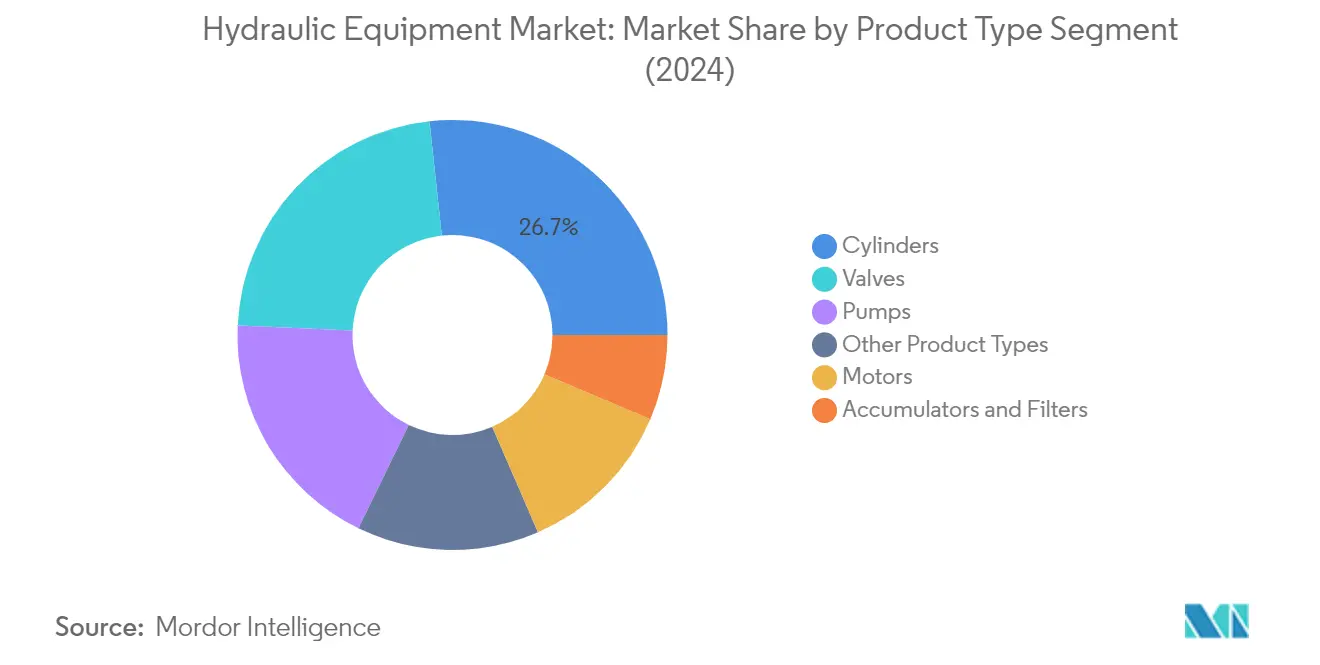
Valves Segment in Hydraulic Equipment Market
The valves segment is projected to exhibit the highest growth rate of approximately 6% during the forecast period 2024-2029. This growth is primarily driven by the increasing integration of smart valve technologies with wireless connectivity, enabling easier system commissioning and diagnostics through smart devices. The segment's expansion is further supported by the rising demand for precision control in industrial automation and the growing need for energy-efficient hydraulic systems. Additionally, the development of advanced valve solutions with improved pressure and flow control capabilities, particularly in critical applications across oil and gas, manufacturing, and renewable energy sectors, is contributing to the segment's accelerated growth trajectory.
Remaining Segments in Hydraulic Equipment Market
The hydraulic equipment market encompasses several other vital segments including pumps, motors, accumulators and filters, and other product types. Pumps play a crucial role in power generation and fluid transfer applications, while motors are essential for providing rotary motion in various industrial applications. Accumulators and filters are fundamental for maintaining system efficiency and fluid quality, helping prevent contamination and ensuring smooth operation. Other product types, including transmission systems and fluid connectors, contribute to the overall functionality and integration of hydraulic systems across different applications. Each of these segments serves specific functions in hydraulic systems, collectively supporting the diverse requirements of end-user industries.
Segment Analysis: By End-User Vertical
Construction Segment in Fluid Power Equipment Market
The construction segment maintains its position as the dominant force in the fluid power equipment market, commanding approximately 17% market share in 2024. This substantial market presence is driven by the extensive use of hydraulic equipment in construction machinery, including excavators, steamrollers, backhoe loaders, concrete machines, drilling rigs, and wheel loaders. The segment's strength is further reinforced by the increasing adoption of advanced hydraulic systems that provide precise control and efficient power transfer in construction applications. Modern construction sites heavily rely on hydraulic systems attached to moving vehicles, as they eliminate the need for mechanical connections like gears or drive shafts, offering superior flexibility and power density compared to other power transmission methods.
Agriculture Segment in Fluid Power Equipment Market
The agriculture segment is projected to exhibit the highest growth rate of approximately 6% during the forecast period 2024-2029, driven by the increasing mechanization of farming operations worldwide. This growth is attributed to the rising adoption of hydraulic equipment in various agricultural applications, from cattle breeding to harvesting and crop planting. The segment's expansion is further supported by the critical role of hydraulic systems in modern agricultural machinery, including tractors with hydraulic drives, sprayers with hydrostatically powered wheel motors, and combine harvesters with sophisticated hydraulic systems. The integration of smart hydraulic technologies in agricultural equipment, coupled with the growing need for improved efficiency in farming operations, continues to drive innovation and adoption in this segment.
Remaining Segments in Fluid Power Equipment Market End-User Verticals
The fluid power products market encompasses several other significant segments including material handling, oil & gas, aerospace & defense, machine tools, and hydraulic tools. The material handling segment plays a crucial role in manufacturing and logistics operations, while the oil & gas sector utilizes hydraulic equipment extensively in drilling and exploration activities. The aerospace & defense segment focuses on high-pressure applications and specialized hydraulic systems for aircraft and military equipment. Machine tools and hydraulic tools segments serve industrial manufacturing and maintenance applications respectively. Each of these segments contributes uniquely to the market's diversity, with varying requirements for pressure ratings, precision control, and operational reliability based on their specific applications.
Fluid Power Equipment Market Geography Segment Analysis
Fluid Power Equipment Market in North America
North America represents a mature and technologically advanced fluid power equipment market, holding approximately 31% of the global market share in 2024. The region's dominance is driven by its robust manufacturing sector, particularly in the United States and Canada, where automation and industrial modernization continue to fuel demand. The market is characterized by high adoption rates of both hydraulic and pneumatic systems across diverse industries, including aerospace, construction, and automotive manufacturing. The presence of major fluid power equipment manufacturers and their extensive distribution networks ensures strong market penetration and after-sales support. The region's focus on energy-efficient solutions and sustainable manufacturing practices is driving innovations in fluid power equipment technology, particularly in the development of smart, connected systems. Additionally, the strong emphasis on research and development activities, coupled with stringent quality and safety standards, maintains North America's position as a key market for advanced fluid power solutions.
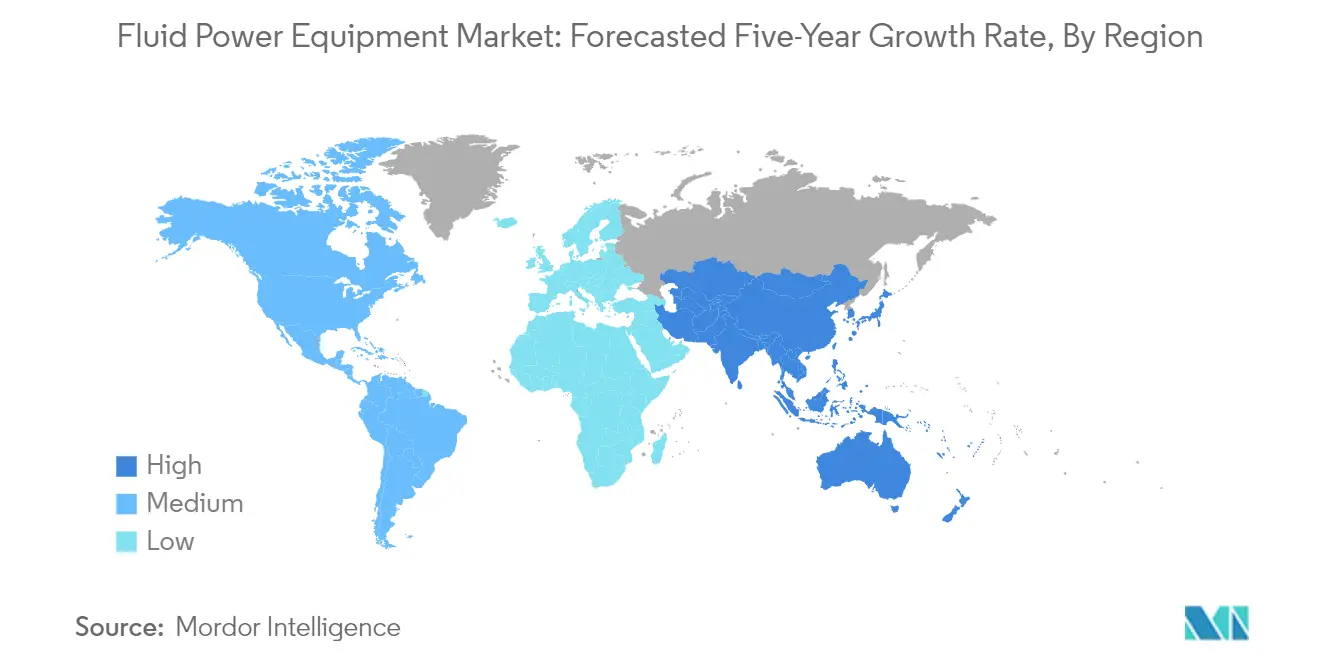
Fluid Power Equipment Market in Europe
Europe maintains its position as a crucial market for fluid power equipment, demonstrating a steady growth rate of approximately 1% between 2019 and 2024. The region's market is characterized by its strong industrial base, particularly in countries like Germany, Italy, and France, which serve as major manufacturing hubs. The European market distinguishes itself through its emphasis on precision engineering and high-quality fluid power solutions, supported by stringent regulatory standards and environmental regulations. The region's commitment to Industry 4.0 initiatives has accelerated the adoption of smart fluid power systems, particularly in the automotive and industrial automation sectors. European manufacturers are at the forefront of developing innovative solutions that integrate digital technologies with traditional fluid power systems. The market benefits from a well-established network of manufacturers, distributors, and service providers, ensuring comprehensive coverage across various industrial sectors. The region's focus on sustainable manufacturing practices and energy efficiency continues to drive innovations in fluid power technology.
Fluid Power Equipment Market in Asia-Pacific
The Asia-Pacific region represents the most dynamic fluid power equipment market, with projections indicating a robust growth rate of approximately 7% from 2024 to 2029. This region's market is driven by rapid industrialization, particularly in countries like China, India, and Southeast Asian nations. The manufacturing sector's expansion, coupled with increasing automation across industries, creates substantial opportunities for fluid power equipment deployment. The region's market is characterized by a mix of local manufacturers and international players, fostering healthy competition and technological advancement. Investments in infrastructure development and industrial automation continue to drive demand for both hydraulic and pneumatic systems. The market benefits from government initiatives promoting industrial modernization and manufacturing excellence. Additionally, the growing focus on energy efficiency and environmental sustainability is encouraging the adoption of advanced fluid power solutions. The region's diverse industrial base, ranging from automotive and electronics to construction and mining, provides multiple growth avenues for fluid power equipment manufacturers.
Fluid Power Equipment Market in Rest of the World
The Rest of the World market, encompassing Latin America, the Middle East, and Africa, presents diverse opportunities for fluid power equipment manufacturers. These regions are characterized by varying levels of industrial development and specific sector-focused growth. The Middle East's strong oil and gas sector continues to drive demand for specialized fluid power solutions, while mining operations in Africa create sustained demand for heavy-duty hydraulic systems. Latin American countries are showing increasing adoption of automation technologies, particularly in their manufacturing and agricultural sectors. The market in these regions is characterized by a growing focus on infrastructure development and industrial modernization. Local service and support networks are expanding, improving access to fluid power solutions and maintenance services. The regions show particular interest in robust and reliable systems that can operate in challenging environmental conditions. Investment in training and skill development is helping to build a stronger foundation for the fluid power industry in these emerging markets. The global hydraulic component market by end-use is also gaining traction in these areas, further enhancing growth prospects.
Fluid Power Equipment Industry Overview
Top Companies in Fluid Power Equipment Market
The fluid power equipment market is characterized by intense innovation and strategic consolidation among key players like Bosch Rexroth, Danfoss, Eaton Corporation, Parker-Hannifin, and others. These companies are heavily investing in research and development to develop smart hydraulic and pneumatic solutions aligned with Industry 4.0 requirements, particularly focusing on automation, IoT integration, and energy efficiency. The market demonstrates strong operational agility through localized manufacturing facilities and robust distribution networks spanning multiple continents. Companies are actively pursuing strategic partnerships and acquisitions to enhance their technological capabilities and expand their product portfolios, as evidenced by significant mergers like Danfoss's acquisition of Eaton's hydraulics business. Geographic expansion remains a key focus, with manufacturers establishing production facilities in emerging markets while maintaining a strong presence in mature markets through service centers and channel partners.
Market Consolidation Drives Industry Evolution Pattern
The fluid power equipment market exhibits a relatively consolidated structure dominated by large multinational conglomerates with diverse product portfolios spanning hydraulic and pneumatic systems. These global players leverage their extensive manufacturing capabilities, established brand reputation, and comprehensive aftermarket services to maintain market leadership. The industry landscape is marked by a mix of vertically integrated manufacturers who produce complete fluid power systems and specialized component manufacturers focusing on specific product categories like valves, cylinders, or actuators.
The market is experiencing ongoing consolidation through strategic mergers and acquisitions, as larger players seek to strengthen their market position and expand their technological capabilities. This trend is particularly evident in emerging markets where established companies are acquiring local manufacturers to gain market access and enhance their regional presence. The industry also sees increasing collaboration between traditional fluid power equipment manufacturers and technology companies to develop smart, connected solutions that meet evolving customer demands for digitalization and automation.
Innovation and Service Drive Future Growth
Success in the fluid power industry increasingly depends on manufacturers' ability to innovate and adapt to changing industry requirements. Companies must focus on developing energy-efficient solutions, incorporating digital technologies, and offering comprehensive service packages to maintain a competitive advantage. The integration of IoT capabilities, predictive maintenance features, and remote monitoring systems has become crucial for market success. Additionally, manufacturers need to strengthen their aftermarket services and maintain close relationships with end-users to understand evolving application requirements and provide customized solutions.
Market players must also address the growing demand for environmentally sustainable solutions and comply with increasingly stringent regulations regarding energy efficiency and environmental impact. The threat of substitution from electric alternatives necessitates continuous innovation in hydraulic and pneumatic technologies to improve efficiency and performance. Companies need to invest in building strong distribution networks and technical support capabilities to serve diverse end-user industries effectively. Success also depends on the ability to offer flexible, modular solutions that can be easily integrated into existing systems while providing clear value propositions in terms of total cost of ownership. Notably, companies like Festo are enhancing their market share by focusing on these innovative strategies.
Fluid Power Equipment Market Leaders
-
Bosch-Rexroth AG
-
Danfoss AS
-
Eaton Corporation
-
Festo AG
-
SMC Corporation
- *Disclaimer: Major Players sorted in no particular order
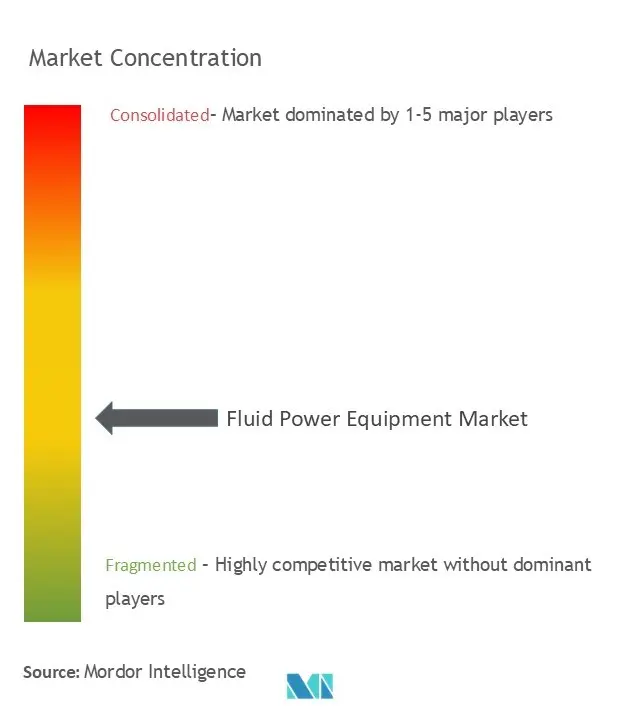
Fluid Power Equipment Market News
- Januray 2024 - Bosch Rexroth announced a partnership with thermal management manufacturer Modine. The two groups are working together to introduce Modine EVantage (™) thermal management systems into Bosch Rexroth's range of eLION products for electrified off-highway machinery on a global scale. Rexroth eLION systems and Modine EVantage thermal management systems work together to enhance the electrification of customer platforms in the off-highway sector by providing efficient EV technology with reduced emissions and improved performance. As more mobile machines are being electrified, it is essential to efficiently control the thermal output of important components.
- November 2023 - Danfoss Launches New Hydraulic, Electrification and Autonomy Solutions, The newly launched H1F fixed displacement bent axis hydraulic motor is designed for open- and closed-circuit applications in agriculture, construction and forestry machinery.
- June 2023 - Bosch Rexroth has opened a new production plant to meet the increasing need for mobile hydraulic and factory automation technology. By expanding their manufacturing capacity in this area, the company can easily respond more quickly to customer needs and satisfy the rising demand for products, especially for agricultural and construction machinery as well as OEM machine manufacturers in North America.
Fluid Power Equipment Market Report - Table of Contents
1. INTRODUCTION
- 1.1 Study Assumptions and Market Definition
- 1.2 Scope of the Study
2. RESEARCH METHODOLOGY
3. EXECUTIVE SUMMARY
4. GLOBAL HYDRAULIC EQUIPMENT MARKET OUTLOOK
- 4.1 Current Market Scenario
- 4.2 Key Market Influencers - Market Drivers and Challenges
5. MARKET INSIGHTS
-
5.1 Market Drivers
- 5.1.1 Energy Efficiency and Environmental Considerations Shape Market Outlook
- 5.1.2 Advances in Industrial Automation Fuel Demand for Fluid Power Systems
- 5.1.3 Technological Advancements Drive Demand
- 5.2 Market Challenges
6. MARKET SEGMENTATION - GLOBAL HYDRAULIC EQUIPMENT MARKET
-
6.1 By Product Type
- 6.1.1 Pumps
- 6.1.2 Motors
- 6.1.3 Valves
- 6.1.4 Cylinders
- 6.1.5 Accumulators and Filters
- 6.1.6 Other Product Types (Transmission, Fluid Connectors, etc.)
-
6.2 By End-user Vertical
- 6.2.1 Construction
- 6.2.2 Agriculture
- 6.2.3 Material Handling
- 6.2.4 Oil and Gas
- 6.2.5 Aerospace and Defense
- 6.2.6 Machine Tools
- 6.2.7 Hydraulic Tools
- 6.2.8 Other End-user Verticals
-
6.3 By Geography
- 6.3.1 North America
- 6.3.2 Europe
- 6.3.3 Asia-Pacific
- 6.3.4 Rest of the World
- 6.4 Vendor Market Share Analysis - Hydraulic Equipment Market
7. GLOBAL PNEUMATIC EQUIPMENT MARKET OUTLOOK
- 7.1 Current Market Scenario
- 7.2 Key Market Influencers - Market Drivers and Challenges
8. MARKET SEGMENTATION - GLOBAL PNEUMATIC EQUIPMENT MARKET
-
8.1 By Product Type
- 8.1.1 Valves
- 8.1.2 Actuators
- 8.1.3 FRLs
- 8.1.4 Fittings
- 8.1.5 Other Product Types
-
8.2 By End-user Vertical
- 8.2.1 Food Processing and Packaging
- 8.2.2 Automotive
- 8.2.3 Material Handling and Assembly
- 8.2.4 Chemicals/Plastics/Oil
- 8.2.5 Semiconductor and Electronics
- 8.2.6 Metalworking
- 8.2.7 Paper and Printing
- 8.2.8 Life Sciences
- 8.2.9 Other End-user Verticals
-
8.3 By Geography
- 8.3.1 North America
- 8.3.2 Europe
- 8.3.3 Asia-Pacific
- 8.3.4 Rest of the World
- 8.4 Vendor Market Share Analysis - Pneumatic Equipment Market
9. COMPETITIVE LANDSCAPE
-
9.1 Company Profiles*
- 9.1.1 Bosch-Rexroth AG
- 9.1.2 Danfoss AS
- 9.1.3 Eaton Corporation
- 9.1.4 Hydac
- 9.1.5 Parker-Hannifin Corporation
- 9.1.6 HydraForce Inc.
- 9.1.7 Kawasaki Heavy Industries Limited
- 9.1.8 Nachi-Fujikoshi Corp.
- 9.1.9 Festo AG
- 9.1.10 SMC Corporation
- 9.1.11 Emerson Electric Co.
- 9.1.12 Schlumberger Limited
- 9.1.13 IMI Precision Engineering
- 9.1.14 Parker Hannifin Corporation
- 9.1.15 Ingersoll Rand Inc.
- 9.1.16 Flowserve BV (Flowserve Corporation)
- 9.1.17 Neles Oyj
- 9.2 Market Outlook - Pneumatic Equipment Market
- 9.3 Market Outlook - Hydraulic Equipment Market
Fluid Power Equipment Industry Segmentation
Fluid power is a term describing hydraulics and pneumatics technologies. Fluid Power Equipment comprises equipment that uses a fluid (liquid or gas) to transmit power from one location to another. The fluid is a liquid (usually oil) with hydraulics, whereas pneumatics uses gas (usually compressed air).
For both the hydraulic and pneumatic categories, the study only considers revenue accrued from the sales of equipment used in the production of end products. It does not reflect the revenues of finished goods.
The fluid power equipment market in which hydraulic equipment market is segmented by product type (pumps, motors, valves, cylinders, accumulators & filters), end-user vertical (construction, agriculture, material handling, oil and gas, aerospace and defense, machine tools, hydraulic tools) and geography (North America, Europe, Asia-Pacific, rest of the World). The pneumatic equipment market is segmented by product type (valves, actuators, FRLs, fittings), end-user vertical (food processing and packaging, automotive, material handling and assembly, chemicals/plastics/oil, semiconductor, and electronics, metalworking, paper and printing, life sciences) and geography (North America, Europe, Asia-Pacific, rest of the World). The market sizes and forecasts are provided in terms of value (USD) for all the above segments.
| By Product Type | Valves |
| Actuators | |
| FRLs | |
| Fittings | |
| Other Product Types | |
| By End-user Vertical | Food Processing and Packaging |
| Automotive | |
| Material Handling and Assembly | |
| Chemicals/Plastics/Oil | |
| Semiconductor and Electronics | |
| Metalworking | |
| Paper and Printing | |
| Life Sciences | |
| Other End-user Verticals | |
| By Geography | North America |
| Europe | |
| Asia-Pacific | |
| Rest of the World |
Fluid Power Equipment Market Research FAQs
How big is the Fluid Power Equipment Market?
The Fluid Power Equipment Market size is expected to reach USD 69.98 billion in 2025 and grow at a CAGR of 5.36% to reach USD 90.86 billion by 2030.
What is the current Fluid Power Equipment Market size?
In 2025, the Fluid Power Equipment Market size is expected to reach USD 69.98 billion.
Who are the key players in Fluid Power Equipment Market?
Bosch-Rexroth AG, Danfoss AS, Eaton Corporation, Festo AG and SMC Corporation are the major companies operating in the Fluid Power Equipment Market.
Which is the fastest growing region in Fluid Power Equipment Market?
North America is estimated to grow at the highest CAGR over the forecast period (2025-2030).
Which region has the biggest share in Fluid Power Equipment Market?
In 2025, the Asia-Pacific accounts for the largest market share in Fluid Power Equipment Market.
What years does this Fluid Power Equipment Market cover, and what was the market size in 2024?
In 2024, the Fluid Power Equipment Market size was estimated at USD 66.23 billion. The report covers the Fluid Power Equipment Market historical market size for years: 2019, 2020, 2021, 2022, 2023 and 2024. The report also forecasts the Fluid Power Equipment Market size for years: 2025, 2026, 2027, 2028, 2029 and 2030.
Our Best Selling Reports
Fluid Power Equipment Market Research
Mordor Intelligence provides a comprehensive analysis of the fluid power equipment market, drawing on decades of expertise in industrial research and consulting. Our extensive coverage includes the entire fluid power industry, offering detailed insights into fluid power products, hydraulic accumulators, and hydraulic fluid connectors. The report also explores automatic power change equipment and fluid aspiration systems. It is available in an easy-to-read report PDF format for immediate download.
The analysis benefits stakeholders across the value chain by examining global hydraulic component trends by product type and end-use applications. Our research covers hydraulic equipment for mobile applications, hydraulic control panels, and power transmission within the fluid power industry. The report provides actionable insights on pump motors in the fluid power sector and regional developments, with a particular focus on North America hydraulic component markets. Stakeholders gain a comprehensive understanding of market dynamics, competitive landscapes, and growth opportunities through a detailed examination of agricultural pneumatic integrated equipment and emerging technological innovations in the sector.




